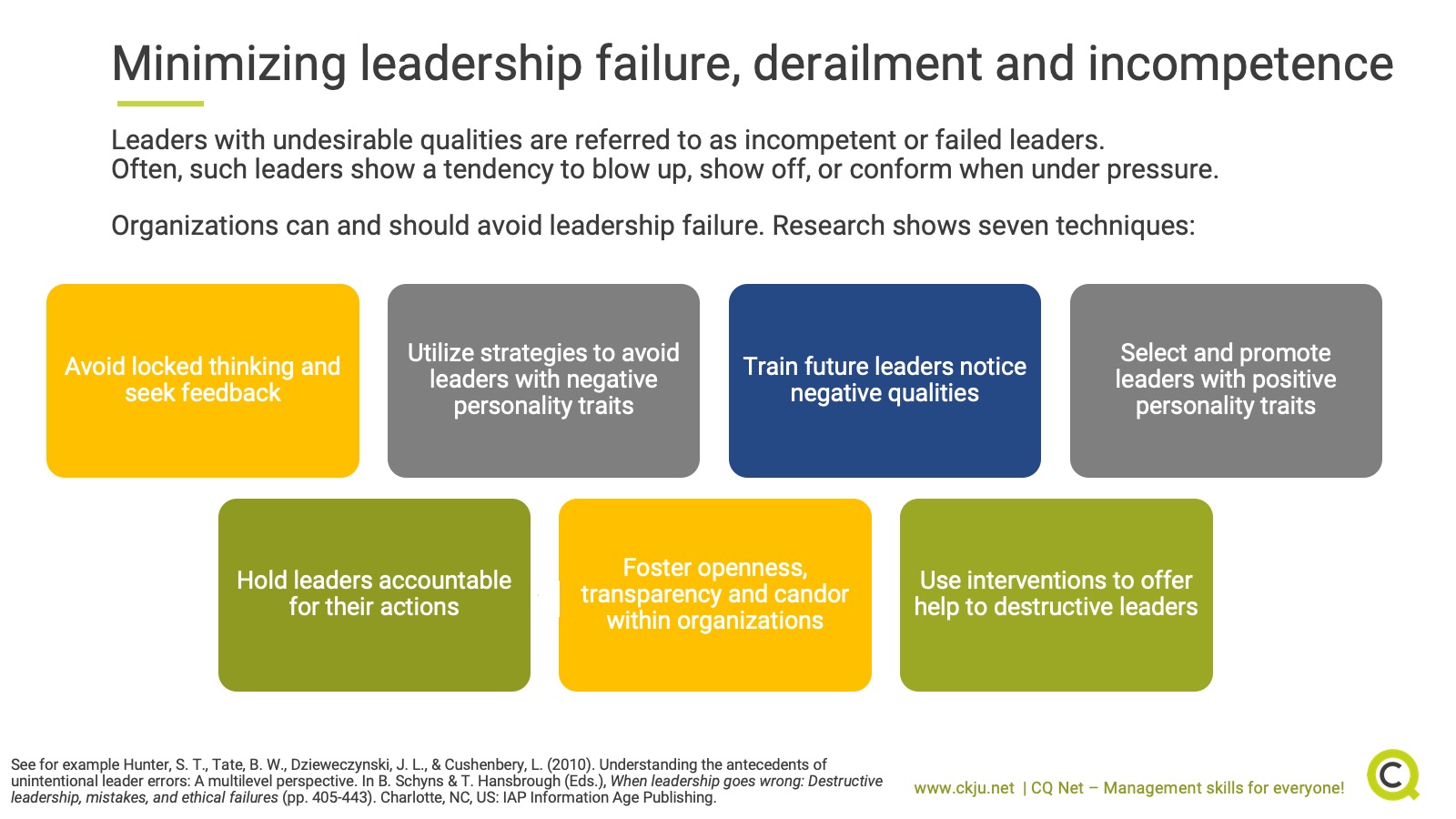- All Management Learning Resources
- Leadership failure

Executive summary
Leadership failure and leadership effectiveness are two important concepts in management. While there is plenty of research about what makes an effective leader, leadership failure and the related concepts of leadership derailment and leadership incompetence have not yet been addressed on a similar detailed level. This is surprising as not all leaders are effective and the estimates for ineffective leaders are high with multiple stories of incompetent bosses in the media. This CQ Dossier describes leadership derailment and incompetence and focuses on the root causes of why leadership fails through an examination of traits and behaviors that are connected to leadership failure. In addition, the effect on organizational performance and measures how to avoid leadership failure are discussed.
Contents
- Executive summary
- What is leadership failure, derailment and incompetence?
- How to measure leadership derailment and incompetence?
- Leadership failure undermines organizational performance
- How to minimize leadership derailment and incompetence?
- Critical appraisal of leadership derailment and incompetence: Solidity Level 3
- Key take-ways
- References and further reading
What is leadership failure, derailment and incompetence?
There is no single agreed-upon definition, theory or concept of leadership failure available yet. However, leadership derailment and leadership incompetence are key concepts that are closely related to leadership failure. Both concepts are somehow overlapping with research studies and theories available that provide a better understanding of leadership failure, its causes and how to avoid it.
Hogan and Hogan (2001) view leadership incompetence or failure as related to having undesirable qualities rather than lacking desirable ones. In fact, their research has identified a key number of characteristics that distinguish incompetent leaders (Hogan & Hogan, 2001) including a tendency to blow up, show off, or conform when under pressure.
The Center of Creative Leadership has also studied leadership incompetence and includes
- problems with interpersonal relationships, including being insensitive, arrogant, and cold;
- a failure to meet business objectives such as not following through and being overly ambitious;
- an inability to build and lead a team,
- an inability to adapt to a transition or to change e.g., conflict with upper management and
- a non-strategic approach (Leslie & Van Velsor, 1996).
Leadership derailment is also part of a cluster of dark leadership characteristics, that also include the personality traits of narcissism and Machiavellianism (McClesky, 2013). Leadership derailment can be likened to a train going off the tracks whereby the manager is involuntarily demoted or terminated when they have reached a certain level yet fail unexpectedly.
How to measure leadership derailment and incompetence?
There have been different approaches to the measurement of leadership incompetence. Hogan and colleagues (Hogan & Hogan, 2001) focus on the personality characteristics of incompetent leaders and their measure also includes leader derailment. The Hogan Development Survey (HDS) assess eleven personality characteristics associated with leadership incompetence or the dark side of leadership.
These characteristics focus on the behaviors of the leaders and show that incompetent leaders tend to be: excitable, skeptical, cautious, reserved, leisurely, bold, colorful, imaginative, diligent and dutiful. However, it is worth noting that this measure has been criticized by other researchers due to problems with reliability and validity (McCleskey, 2013; Harms et al., 2011).
Other researchers have focused on the dark side of leadership, which includes leadership incompetence and have identified key personality traits with narcissism, hubris, and Machiavellianism posited as three core dark traits (Judge et al., 2009). These core dark traits have their own separate measures and can be used to screen out leaders who have these dark traits. However, evidence suggests that the measure lacks validity with HDS dimensions relatively unrelated (Harms et al., 2011).
Leadership failure undermines organizational performance
Leadership incompetence and derailment results in losses for both the individual and the organization. When the leader finally fails, organizational performance declines on top of a variety of other negative side effects (e.g. additional costs for hiring, loss of reputation).
Decline in job satisfaction
Subordinates of incompetent leaders tend to have lower levels of job satisfaction and are more likely to quit, which is an additional financial cost for the company (Erickson et al., 2015; Schyns &. Schilling, 2015).
Increase of psychological stress
Subordinates of incompetent leaders also tend to experience more psychological stress, leading to a decrement in performance and overall well-being (Erickson et al., 2015).
Toxic organizational culture
Leadership incompetence can also devastate an organization leading to a toxic culture, which enhances the likelihood of more incompetent leaders (Erickson et al., 2015).
Increase in unethical behaviors
Leader derailment includes the loss of organizational reputation, increases in unethical behaviors and a loss in well-being for the derailed leader’s subordinates (Wan, 2011).
Abusive supervison
Leaders high in the negative personality trait Machiavellianism are associated with abusive supervision which leads to lower organizational commitment, psychological distress and ´lower job satisfaction (Tepper, 2000; Mackey, Frieder, Brees & Martinko, 2017).
How to minimize leadership derailment and incompetence?
Issues of leadership derailment normally occur when leaders make mistakes. Managers can learn from the mistakes that they make but the organization needs to establish a climate that allows this to happen. Hunter and colleagues have proposed a taxonomy of leader errors and have highlighted how errors could and should be avoided (Hunter, Tate, Dzieweczynski & Cushenbery, 2010). Time plays an important role in leader errors because as timeframes become condensed due to either organizational or leader pressure, mistakes tend to happen because work is rushed (Hunter et al., 2010).
Avoid locked modes of thinking
The other major issue is that leaders can engage in ‘locked modes of thinking,’ particularly in times of stress, when they tend to rely on outdated modes of thinking that are not relevant for the current situation (Hunter et al., 2010). It is important that leaders get enough rest, surround themselves with competent subordinates who can challenge and make decisions, be open to feedback, and actively engage in an analysis of causes without placing unnecessary blame (Hunter et al., 2010).
Avoid core negative personality traits
The issue of leadership incompetence is rooted in core negative personality traits such as narcissism, hubris, and Machiavellianism (Judge et al., 2009). Rarely do leaders with dark personality traits seek development or aim to improve their performance, mainly because of the very nature of their personality traits. Consequently, it is essential that organizations utilize strategies to help minimize leadership incompetence.
Train future leaders to be aware of negative qualities
Organizations can also train future leaders to increase awareness of their own negative qualities and can encourage leaders to seek interventions such as coaching or counseling (Conger, 1990). There are several strategies to address dark leadership and these fall into two camps – selection and screening or leadership interventions. This can be achieved by utlizing personality tests such as the NEO personality inventory to better understand individual personality traits, strengths and potential weaknesses.
Select and promote the right leaders
One way to minimize leadership incompetence is through using selection strategies that aim to select leadership candidates with positive personality traits e.g., conscientiousness to screen out candidates with negative personality traits e.g., hostility, neuroticism, and anxiety (Schaubroeck, Walumbwa, Ganster, & Kepes, 2007). If the screening of leaders with the potential to derail does not occur during selection or promotion, direct intervention with the leader is required (Hogan & Hogan, 2001).
These strategies can help avoid the selection of incompetent leaders although trying to use these strategies can be daunting particularly as candidates who ultimately prove to be incompetent appear as successful and charming during the initial stages of the interview. In fact, Hogan and Hogan (2001) argue that incompetent leader behaviors “coexist with strong social skills.” One way to improve the selection process is through increasing interview skills of human resources professionals who are charged with selection of leaders (McCleskey, 2013).
Provide help for destructive leaders
Some researchers argue that destructive leadership can be changed through intervention. Maccoby (2004) argues that leaders who display dark leadership qualities might benefit from therapy because they need help with their feelings of “rage, alienation, and grandiosity” (2004, p100). Other organizational scholars also perceive treatment such as psychoanalysis to be beneficial for individuals who display dark leadership characteristics (Schaubroeck et al., 2007).
Foster openness, transparency and candor
Several practitioners and researchers view leadership incompetence as a mixture of negative characteristics and ineffective behaviors such as inappropriate leadership information handling and leadership strategies (Hughes, 2014). A review of leadership incompetence also reveals a failure to learn from past experiences or clinging to a leadership mindset that leads to arrogance and organizational hubris (Hughes, 2014).
Hughes (2014) recommends fostering a need for openness, transparency and candor within organizations and this is one way in which organizations can decrease leadership incompetence through promoting a climate that encourages ethical behavior and good interpersonal relationships.
Hold leaders accountable for their actions
Many times, when leaders are indecisive, it is because they are not held accountable for their actions so enabling a transparent climate is important. Leadership derailment often occurs because there is a disconnect between the skills and competencies of the leaders and the requirement of the new job responsibilities (McCleskey, 2013).
Critical appraisal of leadership derailment and incompetence: Solidity Level 3
In conclusion, leadership incompetence and derailment are major problems for organizations and the research suggests several ways to deal with the destructive effects that incompetent and derailed leaders bring to the workplace.
Most of the research on leadership has focused on effective leadership behaviors. Although the research on leadership incompetence and leadership derailment exists, there needs to be more done particularly due to the criticism of existing measures that have not demonstrated thorough psychometric properties. This dossier is graded a 3 (out of 5) on the solidity rating.
Key take-ways
- Incompetent leaders tend to blow up, show off, or conform when under pressure
- Narcissism, hubris, and Machiavellianism are three core traits associated with incompetent leadership
- Leadership incompetence and derailment results in losses for both the individual and the organization.
- Strategies to address incompetent and derailed leadership include selection and screening or leadership interventions
Management skills newsletter
Join our monthly newsletter to receive management tips, tricks and insights directly into your inbox!
References and further reading
Conger, J. A. (1990). The dark side of leadership. Organizational Dynamics, 19, 2, 44-55.
Erickson, A. et al., (2015). Destructive leadership, Organizational Dynamics.
Leslie, J.B. & Van Velsor, E. (1996) A Look at Derailment Today: North America and Europe. Greensboro, NC: Center for Creative Leadership.
Harms, P. D., Spain, S. M., & Hannah, S. T. (2011). Leader development and the dark side of personality. Leadership Quarterly, 22, 3, 495-509.
Hogan, R., & Hogan, J. (2001). Assessing leadership: A view from the dark side. International Journal of Selection and Assessment, 9, 40–51.
Hughes, M. (2014). The psychology of leadership incompetence. British Academy of Management Conference Proceedings, 2014.
Hunter, S. T., Tate, B. W., Dzieweczynski, J. L., & Cushenbery, L. (2010). Understanding the antecedents of unintentional leader errors: A multilevel perspective. In B. Schyns & T. Hansbrough (Eds.), When leadership goes wrong: Destructive leadership, mistakes, and ethical failures (pp. 405-443). Charlotte, NC, US: IAP Information Age Publishing.
Judge, T., Piccolo, R., & Kosalka, T. (2009). The bright and dark sides of leader traits: A review and theoretical extension of the leader trait paradigm. The Leadership Quarterly, 20, 855–875.
McCleskey, J. (2013). The dark side of leadership: Measurement, assessment, and intervention. Business Renaissance Quarterly.
Maccoby, M. (2004). Narcissistic leaders: The incredible pros, the inevitable cons. Harvard Business Review, 82(1), 92-101.
Schaubroeck, J., Walumbwa, F. O., Ganster, D. C., & Kepes, S. (2007). Destructive leader traits and the neutralizing influence of an “enriched” job. The Leadership Quarterly, 18(3), 236-251.
Schyns, B., & Schilling, J. (2013). How Bad Are the Effects of Bad Leaders? A Meta-Analysis of Destructive Leadership and its Outcomes. The Leadership Quarterly, 24, 1, 138—158
Wan, K. E. (2011). Understanding managerial derailment. Ethos, 9, 1-4.
About the Author








